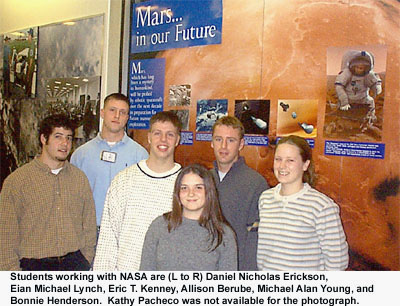 Students Working with NASA on a few Mars Mission studies...
Students Working with NASA on a few Mars Mission studies...There are seven students spending two months at NASA's Johnson Space Center performing studies relating to the Mission to Mars. The students are from Worcester Polytechnic Institute in Worcester, Massachusetts, and are working with NASA to complete their senior projects. There are three groups working on gloves, glove boxes and clean room contamination control with respect to the handling of Mars samples. Descriptions of the individual projects are below:
Controlling organic outgassing in clean rooms
The focus of this study is on the two class-10 Genesis Mission clean rooms, which are located in Building 31 of the Johnson Space Center. Past testing has shown that there are organic contaminants being outgassed from certain materials present in the rooms. Clean rooms are classed based on the number of 0.5 micron or larger particles that are present per cubic foot in the room; however, the amount of molecular species in the room is not accounted for under these specifications. These contaminants pose a problem when associated to Mars sample handling. Any foreign Earth material that is exposed to the samples may result in false assumptions about conditions on Mars.
The goal of the project is to determine the sources of the molecular contamination, recommend ways the clean room can be altered to reduce or eliminate these contaminants, and ensure that the environment is suitable for Mars sample return handling. Past tests on outgassing in the rooms are being analyzed, and further testing will be done to verify what materials are outgassing the organics being found in the rooms. Low-outgassing materials and products are being investigated so that recommendations on alternate materials can be made. The two students currently working on this study are Dan Erickson (WPI Chemistry major) and Kathy Pacheco (WPI Chemical Engineering major). JSC's Ed Mickelson and Judy Allton are advising the project.
Glove Material Selection
The purpose of this project is to investigate the best glove material for the lunar sample handling facility and the future Mars sample receiving facility. Gloves are used in gloveboxes to prevent cross-contamination between the operator and the sample and to preserve the condition of the sample. In order to ensure the sample remains pristine, the glove should not allow contaminants to pass through. The material used for the gloves should not allow oxygen and water vapor to permeate from the clean room environment into the glovebox or allow carbon dioxide to permeate from the sample to the clean room. The material also should not release particles that may contaminate the sample being handled. Glovebox glove manufactures have recommended hypalon, viton and butyl rubber as possible glove materials that would meet these standards.
Renco Corporation, North Safety Products, Latex Technology Inc., and Guardian Manufacturing have provided samples of the recommended materials. These samples will be tested for permeability, particulate extraction, offgassing products, and flexibility. The glove material that provides the best overall results will be recommended for use. The two students currently working on this project are Eric Kenney (WPI Chemical Engineering major) and Mike Young (WPI Chemical Engineering major). Prof. Karen McNamara from WPI is advising the project, along with Judy Allton from JSC and Eric Dahlgren, a WPI graduate student who assists in the project while at JSC.
Cold Glove Box Design
The goal of our project is to identify design requirements for a preliminary interaction unit that would define a basic system for Mars Return Sample Handling at cold conditions. These conditions require a proposed operation temperature of -40şC in an attempt to duplicate the environment on the Martian surface and prevent the loss of valuable geological research from heat effects on the returned samples. Originally, the unit was termed a glove box, but has been revised to a Sample Isolation and Containment Unit (SICU) due to anticipated design characteristics that distinguish the unit from preceding systems. These characteristics were basic, but vital in defining potential applications and capabilities of the unit, and include structure, cold source, internal atmosphere, sample manipulation, cleanliness and sterility, and possible monitoring equipment. We have chosen to focus our efforts on two of these factors primarily because of our chemical engineering background. The structure and cold source of the unit will be the bulk of our design work. As of now, we have prioritized structural aspects that outline the overall design of the SICU such as shape, visibility options, sample manipulation and transfer, equipment storage, and atmospheric flux. We have reviewed options under these categories that have brought new and exciting designs into consideration. In addition, we are in the process of devising leakage rate tests for each design. In the upcoming weeks, we will concentrate on defining aspects of the cold source for the SICU in regards to equipment, location, and heat transfer. In the end, we hope to present our design proposals and recommend the best overall design for the SICU. (The Lockheed Martin supervisor for this project is Lisa Vidonic.)